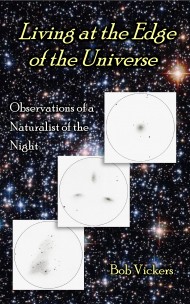The last week in March, Melissa and I took a trip to visit our son and his wife in northern Florida. They have just moved to a new place and, as it turns out, it is about thirty-nine miles from the Chiefland Astronomy Village, near Chiefland, Florida. Begun in the late 1980’s, all the lots in this “village” are owned by amateur astronomers. Most have their own observatories and there is also an observing field for the members of their Chiefland Observers Group. I wanted to take the opportunity to check the place out because I was considering bringing my scope on one of our visits and doing some observing in their dark skies. I didn’t have the scope with me this trip nor did I have time to observe (it was full Moon, anyway). I did however, have time for a short tour of the place. I got on the Chiefland Observers Yahoo Group, contacted the administrator, Joe Mize, and we set up a time to meet. On the day we went down to Chiefland, it was raw and windy (not your typical Florida weather) and I really hated to make Joe come out in the cold. But, he was very gracious and insisted on showing us around the observing field and its facilities. Everything was very open with good horizons. Not so good on a windy day but good for observing.
 Former residence of Tom & Jeanie Clark at the edge of the Chiefland Observers Field. Copyright (c) 2013 Robert D. Vickers, Jr.
Former residence of Tom & Jeanie Clark at the edge of the Chiefland Observers Field. Copyright (c) 2013 Robert D. Vickers, Jr.Joe also showed us his setup, a fourteen inch Richey-Chrétien Cassegrain with a custom water cooled imaging system in a roll-off-roof observatory. Check out his fantastic images at: http://www.cav-sfo.com/
 Joe Mize and his 14″ Richey-Chretien scope with custom water cooled imaging system in roll-off-roof observatory. Copyright (c) 2013 Robert D. Vickers, Jr.
Joe Mize and his 14″ Richey-Chretien scope with custom water cooled imaging system in roll-off-roof observatory. Copyright (c) 2013 Robert D. Vickers, Jr.On our way back from Florida we stopped by the Tellus Science Museum in Cartersville, Georgia, just off I-75. We had been there decades ago when it was just the Weinman Mineral Museum. It is now a major museum with dinosaur skeletons, antique cars, a full scale replica of the Wright Flyer, a 120 seat planetarium, an observatory with twenty inch scope, and an expanded rock and mineral museum. I highly recommend it if you get the chance. http://tellusmuseum.org/
 Me in front of the Tellus Science Museum Observatory which houses a 20″ scope. Copyright (c) 2013 Robert D. Vickers, Jr.
Me in front of the Tellus Science Museum Observatory which houses a 20″ scope. Copyright (c) 2013 Robert D. Vickers, Jr.

